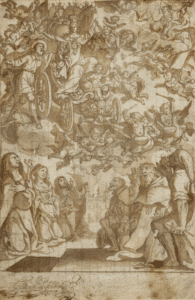Artist
Matías de Irala
(Madrid, 1680-1753)
Friar Matías de Irala was one of the principal disseminators of Spanish Baroque ornamental models. Born in Madrid and descended from an illustrious family, 1 he devoted himself to drawing from a very young age without any instruction, copying foreign engravings. At the age of twenty-four Irala entered the Franciscan Minorites of Saint Francis of Paula as a lay brother in the now defunct monastery of the Victoria on the Carrera de San Jerónimo in Madrid. Once his gifts for drawing and engraving were appreciated he was relieved of his monastic obligations and spent the following years teaching, drawing and producing prints. Only a few canvases by Irala’s hand have survived, including Saint Francis Xavier in the parish church in Navarrete, La Rioja; 2 a few drawings, many of them preparatory designs for prints, such as Decorative border for the front cover of a book in the Museo del Prado (fig. 1); and principally, a large number of individual prints and book illustrations. The latter include the illustrations for various medical treatises such as the Anatomía completa del hombre by Martín Martínez of 1728, the Theatro Chyrurgico Anatómico del cuerpo del hombre viviente of 1729 by Francisco Suárez, and a series of prints published to illustrate a drawing manual with the title Método sucinto y compendioso en cinco simetrías apropriadas a los cinco órdenes de arquitectura con otras reglas útiles, which was produced both as an intended repertoire for painters’ studios and for private students. Despite being a well-established and recognised engraver, in 1753, the year of his death, Irala enrolled to study engraving at the Real Academia de Bellas Artes de San Fernando, 3 offering proof of his humility and desire to continue learning and improving.


